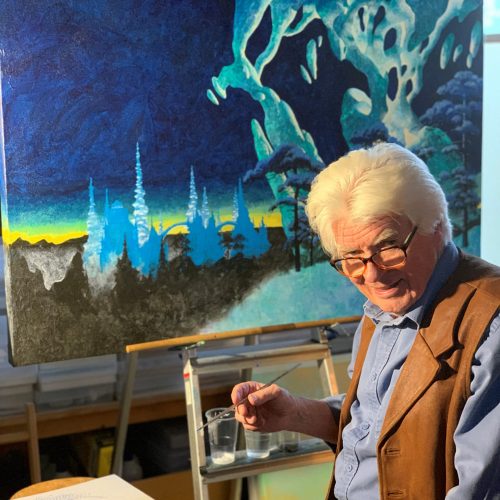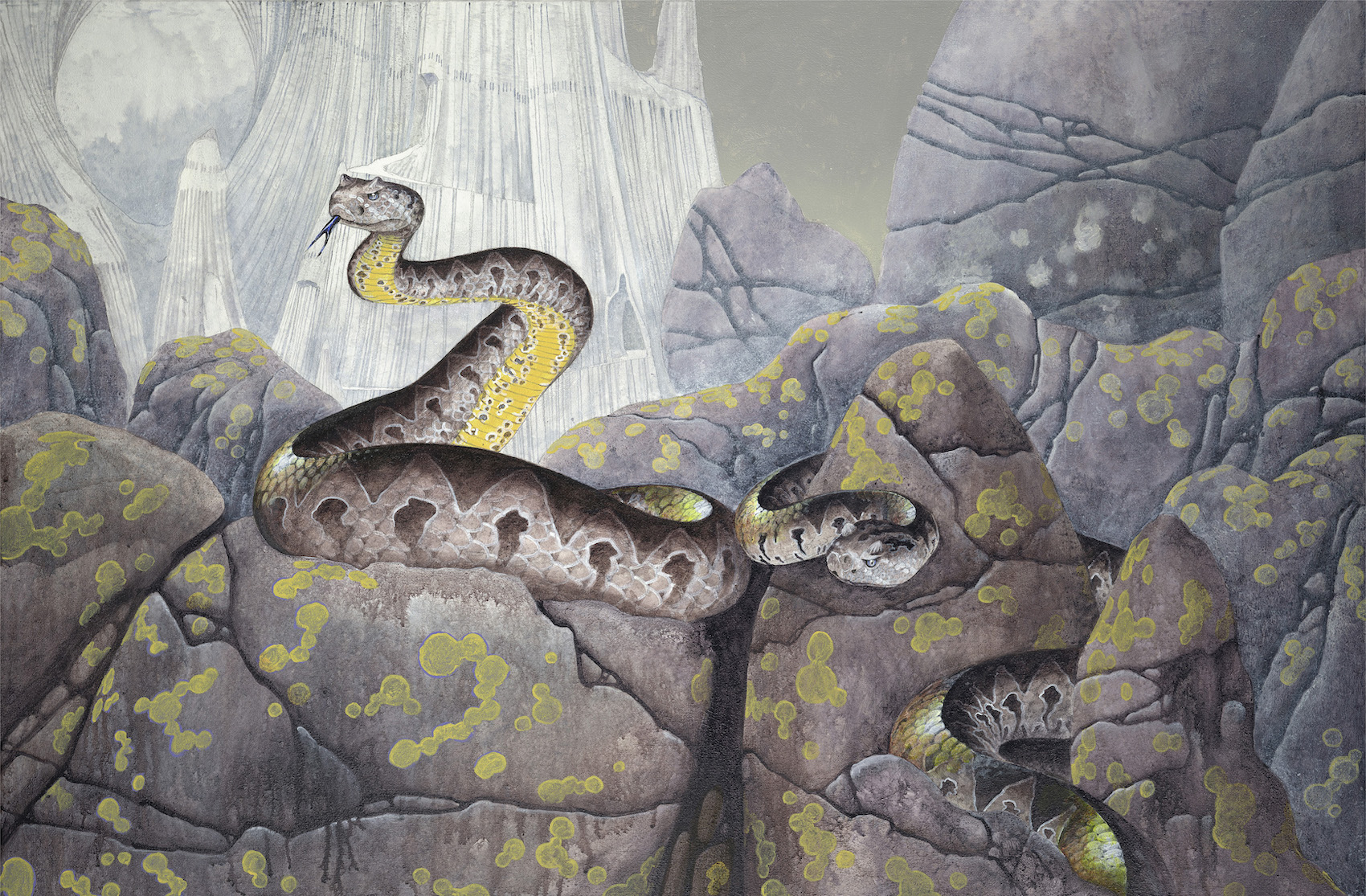Category Archives: News
6 Week Course Painting From Start to Finish
Roger Dean Course £ 1600
Overview
In this six-week, six module course we aim to take you through the process of creating a painting from the idea to the finished piece of work. We will be painting the most integral parts of the painting together in each module. Roger will do a one-hour live session each week with our first group of ten students. You will be given an assignment for the week and will receive written feedback. This first group will be instrumental in developing the course with Roger as we progress to make sure we build the best course possible.
Painters of any ability are welcome from those who are professional painters who want to more tools in their armoury to painters who haven’t lifted a brush yet.
We intend to build the course and expand into other courses but this may be the only fully live one we do. If you want to make sure of this opportunity to learn live with Roger Dean, this is the course to join.
- Week 1: Deciding and designing
- Week 2: Painting the background and setting the mood
- Week 3: Geology and topography, the basics of landscape
- Week 4: Earth reaching the sky, painting trees
- Week 5: Populating the landscape and painting the fauna
- Week 6: Arranging the elements and composing the painting
- Week 1: June 17th Wednesday
- Week 2: June 24th Wednesday
- Week 3: July 1st Wednesday
- Week 4: July 8th Wednesday
- Week 5: July 15th Wednesday
- Week 6: July 22nd Wednesday
Course Outcomes:
By the end of this six week course you will learn the fundamental process of how to create a painting, from the concept to creating the composition and finally executing the work itself. You will learn from Roger his mindset and methodology of the process and be able to incorporate these skills of creativity and technique into your own practice. You will receive a certificate of participation acknowledging your part in the founding of the Roger Dean Art Course. We all sincerely hope that as well as learning from Roger himself you will all have a wonderful and extraordinary experience for this six week that will inspire your creative enthusiasm and be a wonderful memory.
What you will need
You will need a Facebook account for this first course. As it will be live with Roger as opposed to recorded, the sessions will take place in a private group on Facebook. Once you have signed up and given us your Facebook name, we will add you to this closed group. We can chat, share images and discuss progress but the formal feedback will be emailed privately to each student. Also, if for whatever reason you can’t make a live tutoring session, the video will remain in the group until the end of the course so you can catch up whenever you have time.
I recommend you get yourself an audiobook or download a podcast series that will keep you engrossed for at least 50 hours. This is so that while you are working on your assignments your attention can be occupied elsewhere.
Materials
It is not essential to spend a lot of money. There are differences in quality between materials but the important thing is that you have something to paint with (synthetic brushes and acrylic paint) and something to paint on (any board or canvas)
- Paper for sketching
- Watercolour sketchpad
- Pencil (my preference is Mars Staedtler)
- Sharpener
- Eraser
Canvas or board (Any size you like is fine, but bear in mind the bigger it is, the more paint you’ll need to cover it)
- Brushes
- Gesso or primer
- Basic acrylic paint set, choose a set and brand according to your budget
If you want to have or know the most useful colours for me, I’ve listed these below and discuss why they are useful in my live session XIX. I use the brand Golden so the names apply to their series, you do not require these but I recommend them if you like. I also recommend M. Graham & Co. acrylic paint:
- ‘Golden’ Ultramarine blue
- ‘Golden’ Cerulean blue
- ‘Golden’ Chromium oxide green
- ‘Golden’ light phthalo blue
- ‘Golden’ Teal
- ‘Golden’ Naples yellow hue
- ‘Golden’ Burnt umber light
- ‘Golden’ Pyrrole red light
- ‘Golden’ Phthalo blue
- ‘Golden’ Quinacridone magenta
- ‘Golden’ N6 neutral grey
- ‘Golden’ Zinc white
- ‘Golden’ Prime yellow
- ‘Golden’ Titanium white
- ‘Golden’ Mars black
Topographies of the Imagination and the Gates of Delirium
Michael Pearce /MutualArt May 2, 2020
The English artist, one of the great fathers of Imaginative Realism, muses about a new world and the people’s art, and shares with MutualArt an exclusive look at some new paintings.
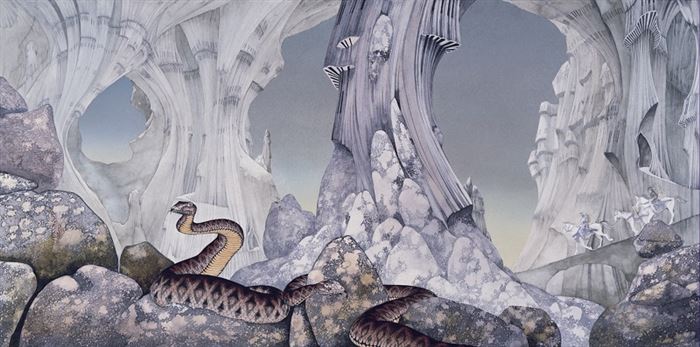
Theron Kabrich quietly gazes at Roger Dean’s watercolor, The Gates of Delirium. He has been Dean’s friend and representative at the San Francisco Art Exchange for thirty years, selling his paintings, drawings, and prints to an international audience of collectors.
Millions of copies of the image have been made.
“Fans and people who know the work, even very famous people … cherish it. It’s one of those things that you’ve seen in books and album covers, but have never seen in person, so when someone’s in the presence of the piece, it’s like everything goes silent, people are in awe that they’re looking at the original work of art,” Kabrich says. “There’s some sort of a devotee attachment to it as an artefact, a relic, an important image, an icon.” The painting was used by the band Yes as the art for their classic recording Relayer, released in 1974. Yes have used Dean’ art for dozens of their albums and continue their close relationship with him today.
The Gates of Delirium is for sale at $6 million.
Purposeful riders canter over a graceful curving bridge beneath the arched stone of ancient morphology, unaware of uncoiling snakes lurking in the foreground. The anxiety of our ancient and reptilian fear ravels against the serpentine elegance of the fantastic landscape, and twists against the direct resolve of the elegant horsemen, hurrying to their fate in a distant battle against dark forces. Their travelling narrative invites us to join them on their way into the sweeping and poetic landscape of wind and water-eroded stone. This twisting and scoured rock is similar to Antelope Canyon, an incredible landscape of colorful rolling waves of sandstone in Arizona, but Dean has never been to that extraordinary place – somehow his creative and inventive mind channeled the rare natural beauty of reality into the imagined world of this wonderful painting.

Roger Dean, Meeting Place, Acrylic on linen, 48 x 72
Dean says the painting was inspired by Tolkien’s literary masterpiece of epic journeying, The Lord of the Rings. In the first of the trilogy, The Fellowship of the Ring, Tolkien wrote a celebrated piece of simple verse, which gives voice to the invitation Dean’s painting offers.
“The road goes ever on and on
Down from the door where it began.
Now far ahead the road has gone,
And I must follow, if I can,
Pursuing it with eager feet,
Until it joins some larger way
Where many paths and errands meet.
And whither then? I cannot say”
If Tolkien’s timeless classic inspired Dean’s enduring fascination with pathways at the beginning of his career, it is Robert McFarlane’s writing about wandering journeys along the ancient tracks twisting through the British landscape that have his attention in the present. Struck by the power of hidden stories, McFarlane moves from place to place in his narratives, taking moments from the history of the countryside and cutting snips of time from time, finding surprising associations between stories and spaces. Dean’s paintings invite imaginative expeditions like McFarlane’s, savoring and relishing fragmented melodies of earth and stone. “I walked and scrambled over many of the mountains in Scotland, Wales and England and I found it hugely inspiring, for my paintings, yes, but for all my work and my life,” Dean says. “A spiritual process really, and a metaphor for acquiring skill and insight and understanding. The mountains though are where I first developed my love of pathways.”
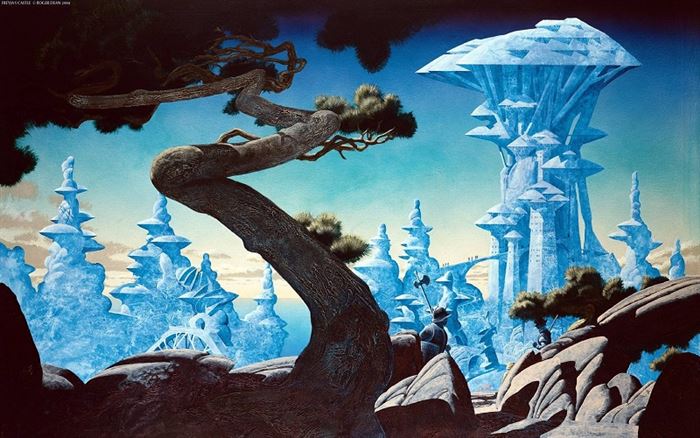
Roger Dean, Freyja’s Castle, Acrylic on Linen, 48 x 72 But as much as he appreciates McFarlane’s work, Dean maintains that “there is not a direct relationship with my paintings, strangely I would also say that about the relationship between my painting and Yes’s music. After the fact, the fit, lovely and fortuitous seems almost magical.”
In McFarlane’s writing, Yes’ music, and Dean’s painting there is a clear love of nature, but also an abstraction of it. The writer, the band and the painter quote the most remarkable moments of their experiences, whether fragile and delicate instants, or flashes of high drama, and craft new worlds from these pieces. The melodies and harmonies of their work are a careful assembly of choice moments of what they observe, abstracted and reformed into something new and beautiful.
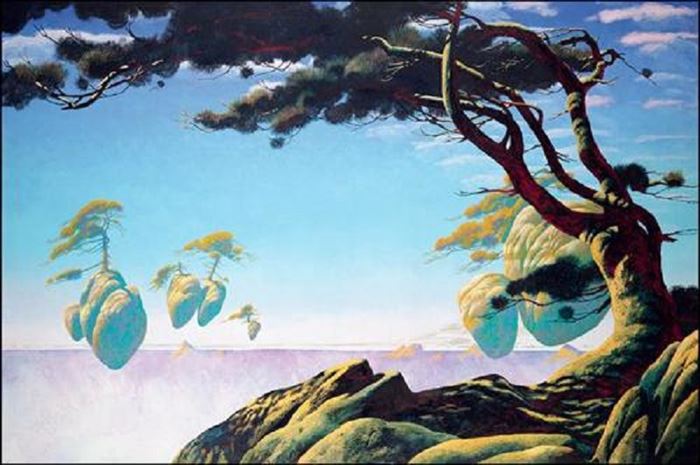
Roger Dean, Floating Islands, Acrylic on Linen, 48 x 72
When he begins shaping a new painting, Dean makes dozens of little thumbnails in his black Moleskine notebooks, developing ideas, redrawing and refining them, then creating a design for a painting from them. Next, he shapes a watercolor study, then he paints abstractly in acrylic onto the canvas, using the carefully conceived design to control and perfect the form, shaping it into the environments of the design. Thus, the painting is based on an exquisite balance between fragmented reality, non-representational texture and design, abstracted from observation. The preliminary and painterly abstract work is left untouched in many of his paintings.
For a rare insight into how he develops his ideas, compare this watercolor sketch for The Gates of Delirium scanned from one of his ‘ideas books’ dating from his college days, to the finished work. The aggressive but gracefully cantilevered battlements of the earlier work have diminished and evolved into subtle allusions to military architecture in the smoother and organically natural stone formations.
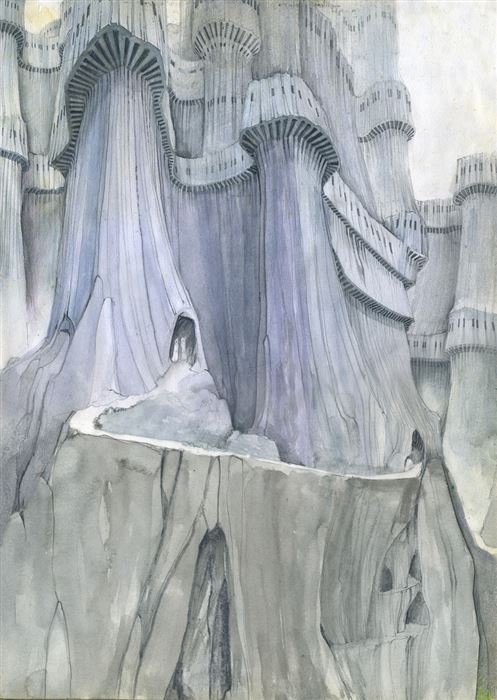
Roger Dean, Relayer Sketch, Watercolor on paper
Dean says he is no idealist, but that he is a sort of propagandist. “I would like people to react to my paintings by thinking ‘Wow, I would like to go there, be there, live there.’ Especially when the works include architecture and pathways, I would like people to think there is a different, better way to do things. The crushing blandness, the pervasive regimentation of our cities, the utter lack of imagination in modern architecture is profoundly unacceptable. I would like us to demand that the world becomes the paradise it could be, a future worth fighting for.”
These are revolutionary and utopian words that call for the creation of a new world, and they naturally recall the renaissance, when great humanist artists crafted a new kind of imagery that was made despite the deeply conservative authority of the guardians of late medieval art.
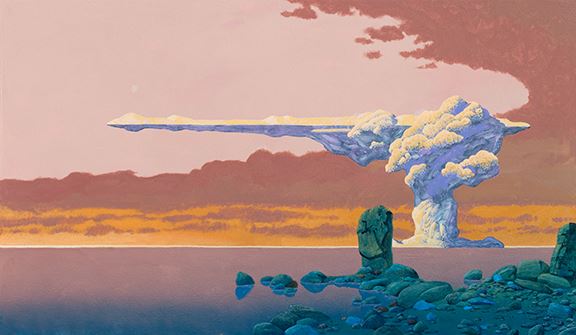
Roger Dean, Mesa, Acrylic on linen, 48 x 72
Dean says there are three important elements necessary for the success of the renaissance, and of the present-day rebirth of imaginative art. Like the renaissance we have great social and cultural confidence. Like the renaissance we have money and wealthy patrons. But, he believes, we lack the intellectual space for artists to develop skills, knowledge and insights, and for the exchange of ideas. “The problem we have today is the incredibly powerful and sustained repression by the profoundly conservative nature of the modern movement in all its aspects in all the visual arts. Supported by academics, critics and dealers. It is a weird, informal, mutually supportive ‘cartel’ of the greed of dealers and the mega-wealthy in collusion with academics on the political left. This produces the bizarre situation where ‘The Peoples Art’ is permanently beyond the reach of ‘The People.’”
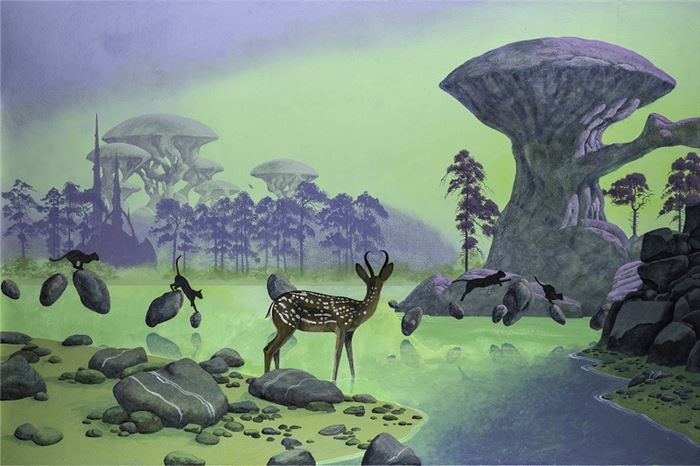
Roger Dean, The Crossing, Acrylic on Linen, 48 x 72
But in the same way that the artists of the renaissance pursued their market in the newly emerging class of wealthy merchants and sidestepped the authoritarian theocracy that had dominated art in their time to find a new market, imaginative realists like Dean have travelled along new pathways to share their work in new worlds. And intelligent discourse about imaginative realism is flourishing on the web, in popular groups and gatherings that form outside the narrow and gloomy domain of the dull and political cartel he points to, and a prosperous and affluent generation of gallerists and collectors who have no interest in surrendering to their diktats provide novel spaces for artists to share their knowledge, insights and ideas. Now, a growing and excited audience for imaginative realism gathers at conventions and in galleries run by people who see Dean as one of the great fathers of the art they love.
“He’s a genius. He’s got a rich imagination and he’s got to paint things that don’t exist and to paint them well and make it graphically supported. There are very few artists who can do that,” Kabrich says. “He’s the tip of the pyramid. He’s the top. He’s the gold standard.”
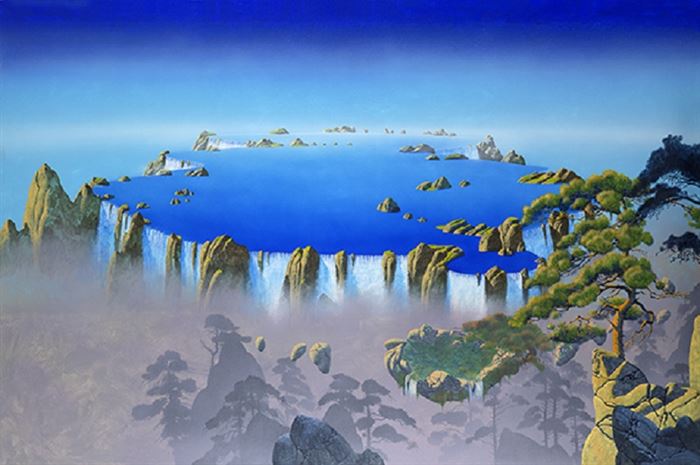
Roger Dean, Close to the Edge III, Acrylic on linen, 48 x 72
And Dean’s wealth and fame comes from his people, the people who love imaginative realism, who see him as an important part of the story of their art, who crowd around him at art fairs and when he tours with Yes, and treat him as a member of the band. They have no interest in the leaden complaints of the grey leaders of the old art order, whose alien and heavy world has nothing in common with the light and dreamlike geology Dean gives them. His people long for the floating world he has created to take form, and wish they could tread his paths, and travel with him from island to island in the topography of his imagination.
Soon, one of them will buy Dean’s Gates of Delirium, for it is an icon of imaginative realism, a sacred symbol from the history of their art.
For more on auctions, exhibitions, and current trends, visit our Magazine Page
Articles you may like
A McMansion of Art: The Non-Biography of Eddie… MutualArt May 29, 2020 The Quintessence of Love in Titian’s Oeuvre MutualArt May 27, 2020 Summer Sale Bonanza MutualArt May 26, 2020
Related Artists
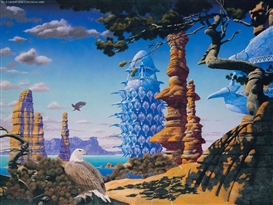
Roger Dean
British, 1944
Get the best stories from MutualArt, straight to your inbox
sign up to our weekly newsletter
Your email will be used in accordance with our Privacy Policy subscribe
